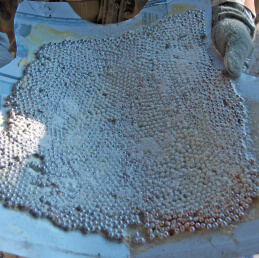CHALLENGE:
To provide proper security and training for CBRNe response personnel by emphasizing the importance of identifying unseen, or unidentified substances, through sampling and intelligence collection.
 BENEFIT:
BENEFIT:
Specific sensory training aids for CBRNe, such as scent generators and smoke systems, used in CBRNE instruction add realism to live immersive training scenarios that will better prepare response teams to meet and recognize unknown dangers.
Sensory Effects Add Realism To CBRNe Training Scenarios
Chemical, biological, radiological and nuclear defense and explosives (CBRNe) pose large-scale real world threats that present extremely dangerous conditions and risk of mass injury, contamination, or loss of life. CBRNe events are, usually, deliberate or aggressive acts with the specific intent of inciting terror or causing targeted physical or environmental harm. CBRNE incidents have the potential to escalate and disrupt society if not identified, prevented, and contained.
According to an article written by Steve Pike for Argon Electronics Global pioneers of CBRNe / HazMat training solutions, “CBRNe missions involve unknown or unidentified substances, with a greater emphasis on the need to identify the substance through sampling and intelligence collection.” Sensory training aids for CBRNe can enhance an individuals’ ability to recognize an odor, malodor as well as assist in visually identifying a harmful toxic cloud if they know what to see, smell, or feel.
Sensory Training Aids for CBRNe Prepare Field Teams
Strange smell is an indicator of a CBRNE attack. Biological and environmental odors and malodors can be associated with clandestine graves, food spoilage, and chemicals in fire debris with evidence of arson.
It is integral to engage personnel in live immersive training that recreates detailed aroma’s with nuances that affect human mind and body reactions. Introducing foul smells often associated with ominous scenarios triggers the olfactory sensory system to recognize that odor in the future. Once exposed to a simulated odor, technicians that must perform in real life operations will have a significant advantage in detecting potentially toxic or noxious odors using a “familiar” warning signal to avoid physical harm.
This idea is supported in H. Scherer, A. Quast, in International Encyclopedia of the Social & Behavioral Sciences, 2001, “The olfactory system belongs to the chemical senses (smell, taste). This sensory function essentially serves the purpose of self-preservation by enabling individuals to recognize food, assess its quality, and receive warning signals (burnt smell, poisons). “
SensoryCo has a complete library of replicated harmful and lethal odors and malodors that imitate toxic compounds, radionuclides or biological weapons that can unleash sensory assaults as well as contaminate environments. Chemical agents such as chlorine gas, mustard gas, cyanide, diesel gas and meth lab smells as well as trauma odors found in medical settings are infused into our aroma cartridges to be dispersed by our specialty scent generators.
In addition, vapor and smoke systems can mimic gaseous releases or create whiteout conditions which can be unforeseen issues in an actual field event. When modeled in a simulated immersive training environment SensoryCo aroma generators and smoke systems become a useful sensory training aids for CBRNe.
CBRNE Missions Require Appropriate Levels of Preparedness
The weaponization of chemical, biological radiological, nuclear, and explosives (CBRNE) agents and the manipulation of computers or other technological devices in order to cause death, destruction, and infrastructure disruption of a principal target require extensive research, study, and training to understand, measure, limit proliferation, maintain responder safety, and limit exposure to threats.
In fact, Chemical,Biological & Nuclear WarFare Magazine, CBNW Issue January 2020 discusses the importance of support, response and recovery training stating, “Comprehensive and common equipping and adequately trained manpower for CBRN security depends on such exercises to provide realistic training to stakeholders. The more practice, the better response.”
Specific CBRNE smoke generation and scent generation training aids add real sensory experience to live immersive training scenarios. The visual cues provided by the presence of a simulated vapor cloud or the introduction of a biological or environmental odor or malodor in an instruction environment directly affects critical mission support services. Increased targeted training and the implementation of first responder field mitigation techniques will allow for better damage control, impact evaluation, threat analysis and vulnerability assessment (TAVA), decontamination, clean up and recovery of probable, likely or current events. SensoryCo products, including aroma and scent generators as well as vapor clouds and smoke systems, provide custom sensory training aids for CBRNe to anticipate and identify specific disaster components.
Examples of atmospheric effects used for CBRNE training include:
Smells: ammonia, nitric acid, IED manufacturing, lewisite, mustard gas, decaying flesh, blood.
Smoke effects: laboratory vapors, car bomb, smoldering café, dense tunnel smoke.
Sprays and vapors: low lying vapors, leaking pipes, de-contamination, chemical spray, WMD gas release.
Available Downloads
![]()
View or download a PDF with a more comprehensive list of aromas
Interservice/Industry Training, Simulation, and Education Conference (I/ITSEC) 2010 Paper No. 10030
The U.S. Army Simulation and Training Technology Center (STTC) performed research to improve the realism of the look, feel and smell of trauma simulations where it was determined that olfactory cues play an important role in memory and training. The study reviewed the idea that the addition of olfactory simulation in immersion training simulations could potentially enhance the perception of engagement, facilitate learning and expand the breadth of skills that can be trained. While the research involved medical trauma settings, the application could be extended to “training combat medics within realistic warfighting scenarios”, and thus, pertain to CBRNe training programs. “Exposing trainees to particular smells may help avoid the shock of first smelling the odors on the battlefield. Preparing for all the sights, sounds, smells and feelings associated with combat may help provide Soldiers with the strength required to face adversity, fear and hardship.”
- Multi-Sensory Immersive Training arrives at I/ITSEC
- Client Case Study: Construction of a Cabin Crew Fire Trainer Inside a Classroom
- Scent Training Enhances Situational Awareness for First Responders
- Hazmat Scent Training Can Save Lives
- SensoryCo Creates Critical Scent Generators for Military Training Environments





